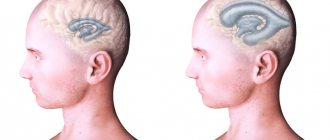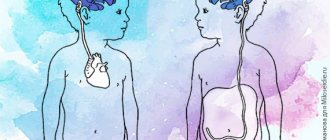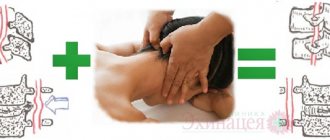Features and classification of the disease
Hydrocephalus is considered a disease called “dropsy of the brain.” The pathology often occurs in newborns, but can also occur in adulthood and implies excessive accumulation of cerebral fluid in the subarachnoid space.
Under the influence of fluid, compression of the brain occurs, which causes neurological pathologies. The main symptoms of hydrocephalus:
- development of strabismus;
- convulsions;
- weakness in the limbs;
- loss of vision;
- gaze paresis.
If the disease progresses, severe neurological changes can lead to decreased mental abilities and death.
Hydrocephalus is divided according to the following characteristics:
- acute, chronic form depending on the course;
- closed and communicating hydrocephalus;
- compensated, decompensated course of the disease;
- external and internal hydrocephalus.
Moderate hydrocephalus in adults occurs with severe symptoms. In parallel, aggressive behavior may develop due to the development of neurasthenia with increased cranial pressure.
Symptoms and severity
According to clinical manifestations, external hydrocephalus in an adult is divided into 3 degrees: mild, moderate and severe. With mild hydrocephalus, the body can independently restore the circulation of cerebrospinal fluid. The patient complains of slight malaise, headache, dizziness, and short-term darkening of the eyes. The average degree of hydrocephalus is manifested by intense signs of brain damage. Patients experience the following symptoms:
- Severe pain in the head, aggravated by physical activity;
- Pressing pain in the eyeballs, the appearance of colored circles of flashes when closing the eyes;
- Feeling of heaviness in the skull;
- Nausea independent of food intake;
- Vomiting without relief.
Sweating occurs periodically. An ophthalmological examination reveals swelling of the optic nerve head. Patients note swelling of the face, weakness, lethargy, and increased fatigue. They are worried about feeling tired in the morning, aggressiveness, increased nervousness, and tearfulness. A depressive state develops. Blood pressure is unstable. Unpleasant sensations intensify when coughing, sneezing, turning or tilting the head.
External hydrocephalus of the brain in an adult is accompanied by neurological symptoms:
- Decreased visual acuity;
- Strabismus;
- Impaired visual perception: double vision, blurred images;
- Paralysis or paresis of the limbs;
- Numbness of the face;
- Decreased sensitivity;
- Impaired coordination.
Patients have speech impairment, difficulty pronouncing sounds and perceiving spoken speech. With severe external hydrocephalus, epileptic and convulsive seizures, frequent fainting, and coma occur. The patient loses memory, intellectual abilities, and his self-care skills decrease.
Patients with occlusive hydrocephalus experience severe headache, nausea and vomiting in the morning. Congestion of the optic discs and signs of axial dislocation of the brain develop. An unfavorable prognostic sign is drowsiness. It intensifies on the eve of a sharp disruption of neurological symptoms. When brain structures are dislocated, cardiac activity and breathing are disrupted.
The clinical picture of chronic hydrocephalus consists of three pathognomonic symptoms: dementia, gait disturbance and urinary incontinence. Dementia is manifested by a decrease in the level of wakefulness, rapid exhaustion of the patient, disorientation in time, the development of severe intellectual disorders, and decreased criticism. Patients become unsure when walking and develop paresis of both lower extremities. The most recent symptom of hydrocephalus is urinary incontinence. This symptom of the disease is more common in men after 50-60 years of age.
Based on the intensity of the manifestation of hydrocephalus, a distinction is made between a moderate form of the disease, which occurs with minor symptoms, and a severe form - the accumulation of a large volume of cerebrospinal fluid provokes the manifestation of acute neurological symptoms.
Depending on the degree of impact on brain structures, external hydrocephalus can be compensated or decompensated. In the presence of compensated hydrocephalus, excessive secretion of cerebrospinal fluid does not affect the brain, but in the decompensated form of the pathological process, regardless of the amount of cerebrospinal fluid, brain function is disrupted and the functional activity of the central nervous system is reduced.
External non-occlusive hydrocephalus occurs when the process of cerebrospinal fluid absorption is disrupted. Atrophic (replacement) hydrocephalus develops most often in older people and is accompanied by the death of brain cells.
Hydrocephalus and military service
The diagnosis of hydrocephalus during military service is considered under Article 23. "Disease Schedule". The fitness category is awarded in accordance with the general condition of the patient. If any violations are recorded, the conscript may be released upon fulfilling his army obligations.
You can serve in the army with hydrocephalus if the diagnosis does not affect the functioning of the brain. When the pathology occurs in a compensated form, the clinical picture does not appear, so the assignment of a category largely depends on the examination at the time of passing the medical commission.
In some cases, fluid accumulation may be due to a brain cyst. If such a diagnosis is identified, surgical intervention is recommended, and the conscript receives a temporary deferment until full recovery.
After completing the necessary rehabilitation course, a conscript can theoretically serve in the army, but in practice the military registration and enlistment office does not carry out conscription if such a clinical picture develops.
Hydrocele of the testicles: is it accepted for military service?
In order for a young man to be exempted from conscription into the army, it is necessary to provide relevant medical documents that will confirm that the patient had a relapse after secondary, in other words, repeated treatment. Moreover, this treatment had to be carried out through surgery. The volume of liquid must exceed 100 ml.
Hydrocele and the army: military service
Hydrocele and the army are something that can become a big obstacle for a person who is going to connect his life with a military career. Why? The fact is that, as a rule, it is necessary to enter higher military educational institutions in good health. To be more precise, this is an essential requirement for admission. Otherwise, mastering the military profession will be simply impossible.
In addition, as noted above, if there is a relapse after surgery and the volume of fluid exceeds 100 ml, it will be impossible to enroll at all.
What should a person who is faced with such a disease, but has a desire to join the army, do? First, you need to try to calm down and think that treatment is a completely possible and probable option. You can resort to traditional medicine recipes, you can resort to surgical intervention. However, it is important to understand that treatment through traditional medicine is unlikely to be effective, and it must be used for at least a month, or even more.
That is why the most optimal option in this case can be considered an operation. Some are afraid of such a measure, but this must be done in order to improve their own health and pass a medical examination upon entry into military service. The occurrence of cases of relapse after surgery is the exception rather than the rule. This is why the village should decide on the procedure. But since the period of time allotted to improve your health may be limited, it is worth considering having the operation paid for. Mainly, this can guarantee excellent quality, but then you will first need to choose a reliable clinic with good reviews.
Syringomyelia and the army
Syringomyelia is a serious disease in which a cavity appears in the spinal cord due to enlargement of the central canal. This pathology is considered chronic and has a slow progression.
Nervous tissue cells (glia) appear in the spinal cord, which disrupt the transmission of nerve impulses to the brain. The disease can be present throughout life and in rare cases cause a bulbar disorder (changes in heart rate, breathing) leading to death.
This disease can progress quickly due to intense physical exertion, therefore, when passing a medical commission, the conscript may be assigned a category of limited fitness or given a complete exemption (category “B”, “D”).
Testicular varicocele
Blood circulation in the genital area is the most dangerous area, because often, even without obvious signs and sensations in a person, it occurs incorrectly. If the veins are in normal condition, then there are no problems, but in recent years the number of young people suffering from pathological dilatation of blood vessels in the groin area has increased significantly. When this occurs near the spermatic cord, varicocele disease develops.
This disease is usually differentiated into three degrees depending on the degree of varicose veins and the possible method of detection. The classification given by the World Health Organization is usually used. She suggests dividing the disease this way:
- the first degree is the least dangerous to human health, in which the dilation of the veins is not visible to the naked eye, moreover, it is not felt during palpation. It can only be detected by a special method or examination;
- second degree - here there are also no visual manifestations of the disease, but a professional will feel the problem point and determine the disease;
- at the third stage of the disease, the situation is extremely complex, dilated veins “bulge” through the skin of the scrotum, the patient experiences pain, and the doctor does not even need to palpate, but an ordinary person can feel the problem.
The second and third degrees of the disease most often make further service impossible, because there is a high risk of losing a testicle or developing infertility. Only if the patient consciously refuses immediate treatment at the second stage can category B-3 be assigned (restriction on the branches of the military where a conscript can serve). At the third degree, confirmed by certificates from doctors, it is impossible to be allowed to serve. Accordingly, whether someone with testicular varicocele is accepted into the army depends only on the actions of the conscript. If he collects the necessary documents and accepts treatment, at least in this conscription campaign he is considered released.
Passing a medical examination
Confirmation of the existing diagnosis is carried out during the passage of a medical commission. The conscript submits all medical reports to the military registration and enlistment office for review. Afterwards, a referral for additional examination is issued.
After receiving the results of the study, the draft commission reviews all the data and makes an appropriate decision on assigning a category of suitability for military service. Hydrocephalus is considered a slowly progressing disease, so the issue of exemption from military obligations may have different opinions.
Passing a medical examination before the army
After receiving the summons, the young man must appear at the military registration and enlistment office with the following documents:
- birth certificate;
- passport;
- outpatient card.
After this, the young man is given the appropriate direction to undergo a military medical commission. In this case, it is recommended to provide appropriate statements confirming the presence of hydrocephalus in the conscript.
List of diseases for which they are not accepted into the army
If a conscript has the following diagnoses, then he automatically receives exemption from military service:
- brain dysfunction (trauma, oncology, various disorders);
- mental disorder of an endogenous type (cyclothymia, schizophrenia, chronic delusional state);
- mental disorders due to intoxication of the body (taking psychotropic substances, physiological changes of a somatic nature);
- stress, psychosis, depression;
- infantile personality disorder (nuclear form of psychopathy, obsessive-phobic syndrome);
- mental disorders due to the use of harmful chemicals (drug addiction, substance abuse, severe alcoholism);
- mental fatigue, which has different forms of flow.
Can you join the army with hydrocephalus?
Lawyer of the Assistance Service for Conscripts in Yakutsk
People with hydrocephalus are accepted into the army. And the point is not that the military registration and enlistment office fulfills the norm for the number of conscripted citizens. The explanation lies in the document regulating the rules of conscription - the Schedule of Illnesses. Let's figure out together why the military registration and enlistment office is adamant in its decision and who can receive a military ID due to illness.








